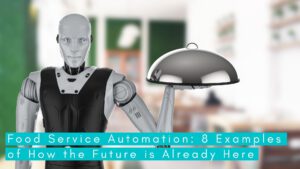‘The Great Resignation’ sounds like the title of a new Western hit starring Clint Eastwood. But, it’s the reality facing the US labor force today. In November 2021, a record 4.5 million Americans quit their jobs – 1 million from the hospitality industry. While this is happening around the globe, the US is unique in that labor costs are sharply rising while declining in other countries.
Various factors have contributed to the labor shortage, including pandemic employment payouts, the appeal of hybrid working, and the desire to seek higher pay. In short, many employees are curious if the grass is greener on the other side.
Despite the ongoing issues, the food service industry continues to step up to the mark. From guest experience to supply chain visibility, businesses harnessed new opportunities for digitalization, recognizing that technology can contribute to a more streamlined, efficient, and customer-centric experience – even in the absence of staff.
To help you recognize where you could benefit from digital updates, we’ve compiled a list of 11 different ways you can reduce labor costs in your quick-service restaurant.
11 Ways to Reduce Labor Costs
1. Grow your tech stack
Throw away the pen and paper, it’s becoming a thing of the past. Sticking with the old-school manual methods can lead to slower and laborious processes that reduce productivity levels and leave room for human error.
A tech stack is a combination of tools, applications, and services that businesses can use to help run operations in a more cost-efficient and time-sensitive manner. Selecting the appropriate tech can be the difference between processes that run themselves and the need to hire extra staff. With a good automated tech stack, you have an additional helping hand.
2. Optimize schedules

One of the driving factors behind the great resignation is the desire for a better work environment and work-life balance. Scheduling rotas and employee times fall under this umbrella.
Every food service business sees spikes in traffic in contrast with quieter footfall, which is where recording this data becomes integral. If you’re able to better understand your business trends, labor budgets, and regulations compliance, you can schedule your employees based on when you need them most.
3. Invest in automation
If a good tech stack can act as an additional person, automation technology will be your next employee of the month. Almost every area of your business operations can be automated, from accounts to scheduling. The primary benefit is that you can replace the need for labor at a time when you may not have too many options.
At Hi Auto, we developed a virtual assistant that helps restaurants automate and make their business more efficient. The main skill of Auto, our assistant, is to automatically take voice orders at restaurant drive-thrus. Auto greets the guest, answers questions, upsells, and enters the order into the POS. The result is shorter wait times, a 4X upsell rate, and, crucially, lower labor costs. With automation, like Auto, human error is a thing of the past.
4. Reduce employee turnover
Every time a business replaces a salaried employee, it could cost six to nine months’ salary on average.
Replacing an employee has several financial implications and often impacts the business more than you may know. Costs include training, onboarding, interview expenses, and advertising. Not to mention the required effort and time, which doesn’t stop once the new employee is onboarded.
It can take up to two years for new employees to reach the same productivity levels as their predecessors, at a training cost of $3500 per staff member.
Focusing on employee retention can help eliminate some of these stressors.
5. Increase morale

Keeping employees in the business is one thing, but maintaining high morale is another. Employee morale includes job satisfaction, attitude, and outlook, which all contribute to a workplace that enjoys what they do and being there each and every day.
Happy employees can have various benefits for a quick-service restaurant, with happy workers being 13% more productive and loyal.
6. Create an effective hiring strategy
While improvements can be made to reduce employee turnover, there will be times when effective hiring is needed. If there isn’t a strategy in place, this hiring process can become tiring for all involved, including the potential new employee. It’s also vital that the person you’re hiring will fit well within the business and the team.
Danny Meyer, the founder of Shake Shack, devised a set of six soft skills dubbed the ‘Hospitality Quotient’ that he believes are necessary qualities in a successful hospitality employee. He uses this as the basis of his ‘49/51’ hiring method, which suggests that technical skills should make up 49% of an employee’s capabilities, and the other 51% comes from their HQ score.
7. Encourage professional development
Hiring internally and promoting staff is not only a viable financial option, but it’s also a great way to boost engagement, morale, and loyalty amongst your team.
51% of employees say they lack a sense of belonging at work. However, professional development opportunities, such as job shadowing and training programs, can help create a future-focused workplace while advancing skills and encouraging collaboration.
If employees are promoted, this also negates the need for advertising (another cost) each time a new role comes up.
8. Check in with your team

Employees who are engaged at work are more likely to improve customer relationships, resulting in a 20% increase in sales. Happy staff equals happy customers.
Whereas a lack of engagement and morale can be attributed to employees feeling unheard and disconnected from their managers.
The best way to keep your finger on the pulse of what’s really going on is to check in with your team regularly. Ask them about their concerns, experiences, and outlook, which will allow them to air any issues and discuss what they like or are lacking in their role.
9. Dish out praise
Offering consistent, fair, and reliable praise can be a tough art to master. But, an excellent way to approach this is to encourage collaboration.
Ask team members to nominate each other for recognition or praise project or task-based successes. This can be a significant morale boost for individuals and can keep teams working together to create the best results as they feel appreciated within their role.
10. Cross-train your team
Cross-training ensures that each employee can handle various tasks and roles, which gives your workforce the ability to collaborate and switch depending on business demands. Not only is this a pillar for team building, but it will also contribute to a consistent QSR service, motivate staff, and create easier planning.
With cross-training, you will no longer have to rely on one employee for a particular task. This can be particularly concerning when an employee is on leave and can jeopardize the business. Training each employee for various roles can be crucial for food handling, customer relationships, and a consistent work ethic.
11. Measure employee efficiency
Although you’ll likely have KPIs in place to measure productivity and efficiency within your team, do your employees understand what their goals are and how they’re contributing to the wider team?
Communicating clear and defined goals and expectations can help keep employees on track individually and as a group. There’s no harm in adapting KPIs either, as long as this is openly conveyed to each team member.
Tech can help pick up the slack

From professional development opportunities to incentives and better scheduling, there are many ways to retain your staff and cut labor costs. There is no quick fix to help you maintain the loyalty and engagement of your team but with consistent effort, time, and thought, this can be made possible.
Currently, QSRs are still recovering from the pandemic and the unstable market activity apparent throughout, so it’s understood if hiring or cross-training your employees may not be at the top of your to-do list. But, these are just some aspects that pay off significantly later down the line.
Above all, it’s clear that technology has filled the gaps that QSRs desperately need, with automation being a great investment for the future.
Thirty years ago, your customers would’ve been startled if they pulled up at the drive-thru and were greeted by anything other than a human, but the world has changed. Nowadays, automation means better service and quicker food – at least in the case of Auto, our conversational AI solution. It can’t clean the spilled chips and the sauce disasters, but it can significantly ease the pressure on your labor force while keeping up with customers.
Take a look at how AI is future-proofing other areas of the food service industry in our blog here.





